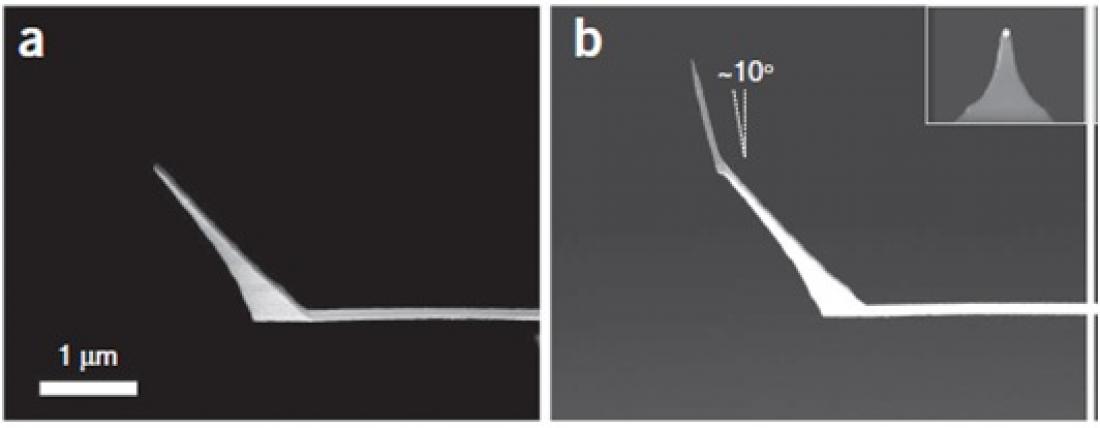Scanning electron microscope images show two different designs of cantilever tip used by Ando and co-workers for high-speed atomic force microscopy.
Press Release
Source: Kanagawa University, Japan, Organization of Frontier Science and Innovation
For immediate release: 4 January 2013
The guide to biomolecular movie-making
(Kanazawa, Japan, 4 January 2013) High-speed atomic force microscopy (HS-AFM) is providing the means to produce dramatic footage of moving biomolecules, and scientists at Kanazawa University leading the field. This research is also described in the inaugural December issue of the Kanazawa University Research Bulletin: http://www.kanazawa-u.ac.jp/research_bulletin/index
Toshio Ando and co-workers at Kanazawa University have developed and used HS-AFM to increase our understanding of several protein systems through microscopic movies of unprecedented spatial and temporal resolution. The team have now published a guide to video recording these important cell components, so that other researchers can benefit from this unique technology.
To produce an image, HS-AFM acquires information on sample height at many points by tapping the sample with the sharp tip of a tiny cantilever. Depending on the application, this might involve recording the amplitude and phase of oscillations, or the resonant frequency of the cantilever.
Ando and co-workers use very small cantilevers that afford 10 to 20 times the sensitivity of larger, conventional cantilevers. Copies of their home-made apparatus are now commercially available through the manufacturer Research Institute of Biomolecule Metrology Co., Ltd. (RIBM) in Tsukuba, and record images at least ten times more quickly than their competitors.
In their paper, published in Nature Protocols, the researchers describe how to prepare substrates to hold samples during HS-AFM, and provide advice on the best ways to take advantage of the equipment. These methods have so far enabled the team to record cargo-carrying proteins ‘walking’ on cell filaments, the rotational motion of motor proteins that provide energy in cells, and the hydrolysis of cellulose. By sharing their experiences of pioneering work in this field, the entire research community will benefit, and learn ever more about the dynamics and structure of vital biological components.
Further information:
Organization of Frontier Science and Innovation
Kanazawa University
Kakuma, Kanazawa, Ishikawa 920-1192, Japan
E-mail: [email protected]
Website: http://www.kanazawa-u.ac.jp/research_bulletin/highlights_001.html
About Kanazawa University
As the leading comprehensive university on the Sea of Japan coast, Kanazawa University has contributed greatly to higher education and academic research in Japan since it was founded in 1949. The University has three colleges and 16 schools offering courses in subjects that include medicine, computer engineering, and humanities.
The University is located on the coast of the Sea of Japan in Kanazawa—a city rich in history and culture. The city of Kanazawa has cultivated a highly respected intellectual profile since the time of the Kaga fiefdom (1598–1867). Kanazawa University is divided into two main campuses: Kakuma and Takaramachi for its approximately 12,200 students including 500 from overseas.
Kanazawa University website: http://www.kanazawa-u.ac.jp/e/index.html



